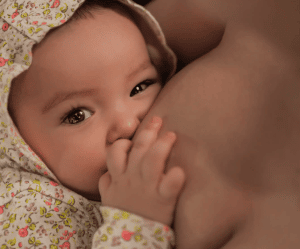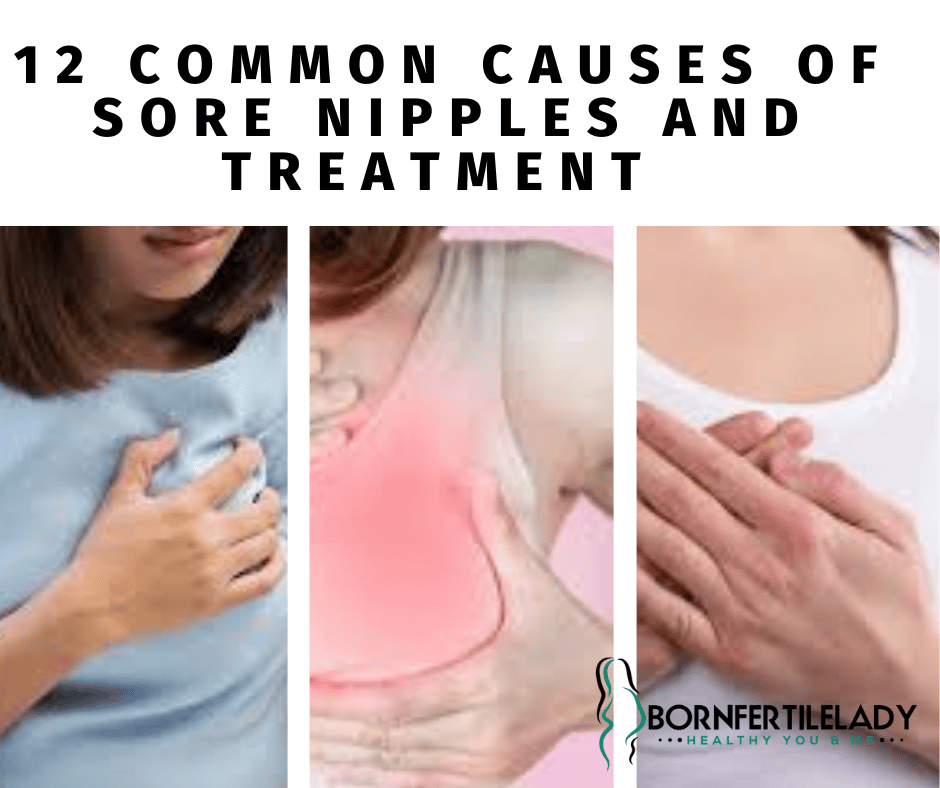There are so many causes of sore nipples ranging from infection, allergic reaction to soaps or body creams, cancer, and even hormonal imbalance.
But Some of the major occasions in a woman’s lifetime where she will experience more pains associated with sore nipples include pregnancy, breastfeeding, and menstruation.

Some of the symptoms of sore nipples include sensitivity, redness of the nipple, change in the texture of the skin around the nipple, crack areola, and even itching of the nipple.
Causes of sore nipples
In this writeup, we will be addressing the various causes of sore nipples which include:
1. Allergy
An allergic reaction or atopic dermatitis may be present if the skin around your nipples is cracking, rough, or peeling (eczema). An allergy to the nipples can lead to:
- Body cream
- Textile softener
- Fabrics
- washing detergent
- Perfume
- Using shaving cream or having facial hair that rubs on your genitalia.
Try to determine whether anything has changed for you recently if the nipple soreness suddenly appeared, such as a new laundry detergent, body lotion, or perfume.
To check if it affects the pain in your nipples, try stopping using it for a week.
For a few days, a topical anti-inflammatory medication might be helpful, but if the soreness persists or gets worse, talk to your doctor.
2. Breastfeeding
Nipple pain is frequently caused by breastfeeding. This is primarily caused by the infant’s feeding style. The baby’s nipple will be against the gum and hard palate if there is not enough breast milk in its mouth. Babies should feed on to the breast firmly and with their nipple at the throat’s back.
The use of a breast pump by a mother may also result in nipple soreness. Too much suction or the use of an improperly fitted nipple shield could be the source of the discomfort. Nipple shields that fit properly and adjusting the breast pump to a more comfortable setting may help ease discomfort.
Read also: How safe is intermittent fasting during breastfeeding?
3. Cancer
Nipple soreness may be a symptom of Paget’s disease, a particular type of malignancy.
It is uncommon and typically only affects one breast and one nipple.
Additional signs and symptoms that could exist include:
- a flattened or inverted nipple
- a nipple discharge that is either yellow or bloody
- Itching or tingling in the nubs
Changes to the skin, such as reddish, dry, crusty, or scaly skin around the areola and nipple.
Consult your doctor if you experience any symptoms similar to those listed above together with nipple pain.
4. Eczema around nipples
The nipple or the flat region around it may exhibit certain symptoms in people who are predisposed to any of these skin disorders (the areola).
A high-quality moisturizer can be applied to the region as a treatment if the irritation is mild.
Look for ceramide-containing products. These waxy materials can seal off the discomfort and promote healing.
Drugstores and pharmacies typically stock over-the-counter medications.
Additionally, doctors can recommend stronger formulas.
5. Friction
Running or other strenuous kinds of exercise frequently cause nipple chafing due to friction, especially in males wearing rough cotton shirts or in women sporting ill-fitting bras or bras made of lace or cotton.
Additionally, sweating softens the skin, and the salt in your perspiration has the potential to crystallize and irritate you further.
Your nipples can rub to the point of bleeding after a long run or workout.
Chafing typically results in burning nipple pain and may also cause the skin to become dry or cracked.
Applying a lubricant or anti-chafing cream to the nipples before exercise can also help reduce nipple chafing.
Wearing synthetic fabrics close to your skin that wick away sweat can also help. draping across the nipples may help.
6. Hygiene products like laundry detergent
Numerous consumer goods, including soaps, shampoos, lotions, and laundry detergents, can irritate the skin.
If nipple sensitivity or irritation is a recent occurrence and there don’t appear to be any other explanations, the cause may be one of the daily touches with skin that household items cause.
Contact dermatitis can be brought on by the chemicals found in many skin care products.
Any exposed area of the body develops red, itchy patches as a result.
Any new product that was used just before a skin reaction could be to blame.
Hypoallergenic, fragrance-free products ought to be kinder to the skin if contact dermatitis is the root of nipple irritation.
Read also : 7 trusted essential oils for breastfeeding with no side effects.
7. Hormonal changes
Nipple and breast discomfort can also be brought on by the typical hormonal shifts that occur during a woman’s monthly cycle.
These signs and symptoms are typically seen in the days leading up to the onset of a woman’s menstruation when rising levels of estrogen and progesterone cause the breasts to feel bloated and pull more liquid to them.
When the period starts, the pain brought on by hormonal changes usually disappears.
A woman may wish to talk to her doctor if this discomfort lasts for more than a few days.
8. Infection
The most typical infection that can affect your nipples is a yeast infection, often known as thrush.
There are huge pores and hair follicles near your nipples that are prone to clogging and infection.
Although women who wear bras made of non-breathable material are more prone to acquire yeast infections on their nipples.
Yeast infections are more likely to originate in locations that are wet and dark where sweat pools, such as under the breasts.
Breast infections including mastitis and yeast infections on the nipples are particularly common among breastfeeding women.
9. Menstruation
Nipple pain and breast tenderness might be brought on by the hormonal changes that take place as part of a woman’s typical monthly cycle.
Just before a woman’s period begins, levels of both estrogen and progesterone rise.
Both of these hormones cause the breasts to feel enlarged and painful by drawing fluid there.
Breast ducts increase due to estrogen, while milk glands enlarge due to progesterone. Additionally typical at this period is nipple soreness.
Symptoms frequently reach their height right before menstruation, then subside and disappear during menstruation.
Although the severity of the symptoms can vary from woman to woman, they are typically more of a nuisance than a cause for concern.
However, you should visit a doctor if you experience any nappy discharge, particularly if it is brown or red.
10. Pregnancy
Nipple discomfort, along with many other physical changes, is a well-known aspect of pregnancy.
It is brought on by both hormonal changes and the stretching of the breast skin during pregnancy.
Applying coconut oil, cocoa butter, or other moisturizing products can ease discomfort.
11. Paget’s disease
Paget’s disease is a milk duct cancer that eventually extends to the nipple and the surrounding region.
Although at first glance it could seem like eczema, the nipples frequently leak blood or yellow fluid.
It frequently just affects one nipple.
Radiation and surgery are used to treat the illness.
12. Sexual activity
Another potential reason for nipple soreness is sexual contact.
Soreness might result from physical contact or nipple-related sexual activity. Giving the nipples some time to recover is a common treatment for this soreness, which is typically only transitory.
A nipple guard or moisturizer can help reduce friction and stop symptoms from growing worse
Read also: Bleeding during early pregnancy:8 possible causes you did not know.
When to seek medical attention
Several indications may point to deeper, more serious problems.
If you observe any of the following, be sure to get medical attention:
- Blunt discharge (might be with blood)
- a stationary, firm bump in the breast
- breasts’ shapes changing, either on one or both
- a rash around the nipple or on it
- The nipple has recessed into breast skin with creases on the breasts (orange peel-like)
Treatment for sore nipples
The cause of sore nipples determines the course of treatment.
Keep an eye out for the aforementioned conditions, and if necessary, treat them correctly under the direction of a healthcare professional.
Additionally, keep a cautious eye out for any new goods that might be irritating.
Particularly dry or cold weather may wreak havoc on the skin, notably on the breasts and nipples.
The nipples may require some sensitive loving care if they appear chapped or crusty.
Limit baths and showers to 10 minutes or less, and avoid using blazing hot water.
It is more prone to deplete the skin of its natural oils and promote dryness.
When you get out of the water, gently pat the skin with a towel until it’s nearly dry, then immediately put on a rich moisturizer.
It’s crucial to speak with a healthcare professional about any symptoms that are bothersome or chronic because the therapy relies on the underlying reason.
